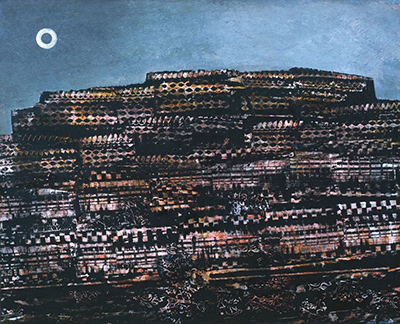The Entire City is an oil on canvas painting by the surrealist artist Max Ernst. The painting measures 60 by 81 centimetre.
Ernst was an important member of a group of writers and artists connected through surrealism during the 1920s. When it comes to the artist's painting technique during this time, Ernst abandoned most of the traditional modes of painting that used a brush with the intention of going beyond painting and started embracing more automatic methods. This included experimental techniques such as grattage and frottage.
To produce the textured effect in this painting, the artist used grattage technique. This involved running a piece of material or object such as a fish backbone or a plank of wood over the painted surface. This process allowed Ernst to process unexpected shapes and marks and imbue his work with the element of chance. Grattage means scraping in French, and it was developed by Ernst from frottage, a similar technique that involves rubbing a crayon or pencil over paper placed on a textured surface.
The Entire City depicts a cityscape consisting of geometric forms that are set against a blue sky. In the painting, the dark shapes comprising the city buildings are marked by floral and striations patterns highlighted in pink and orange tones. In the upper left side corner of this composition, there is a small white ring representing the moon. The layered, textured structures and the lack of definition or detail imply that this city ruins.
The painting brings viewers into the realm of the artist's mind, providing a rare glimpse at his dark state of existence during the Second World War when National Socialism took over his native country Germany. The illuminated ringed moon in the painting offers a light of hope to the people residing in that area.
This painting is part of a set of 12 paintings with the same theme that the artist produced from 1933 to 1937. The 2 final works in this series - created in 1935-7 - are larger than the previous versions. They have a larger area of the sky covering about half of the canvas. The earlier paintings, on the other hand, had the sky covering approximately-quarter of the entire composition. In 1953, Ernst recollected that he created the 1934 version of this painting in the surrealist painter Roland Penrose's studio at the south of France-based Chateau de Pouys where he was hosted as an exile from Germany.




